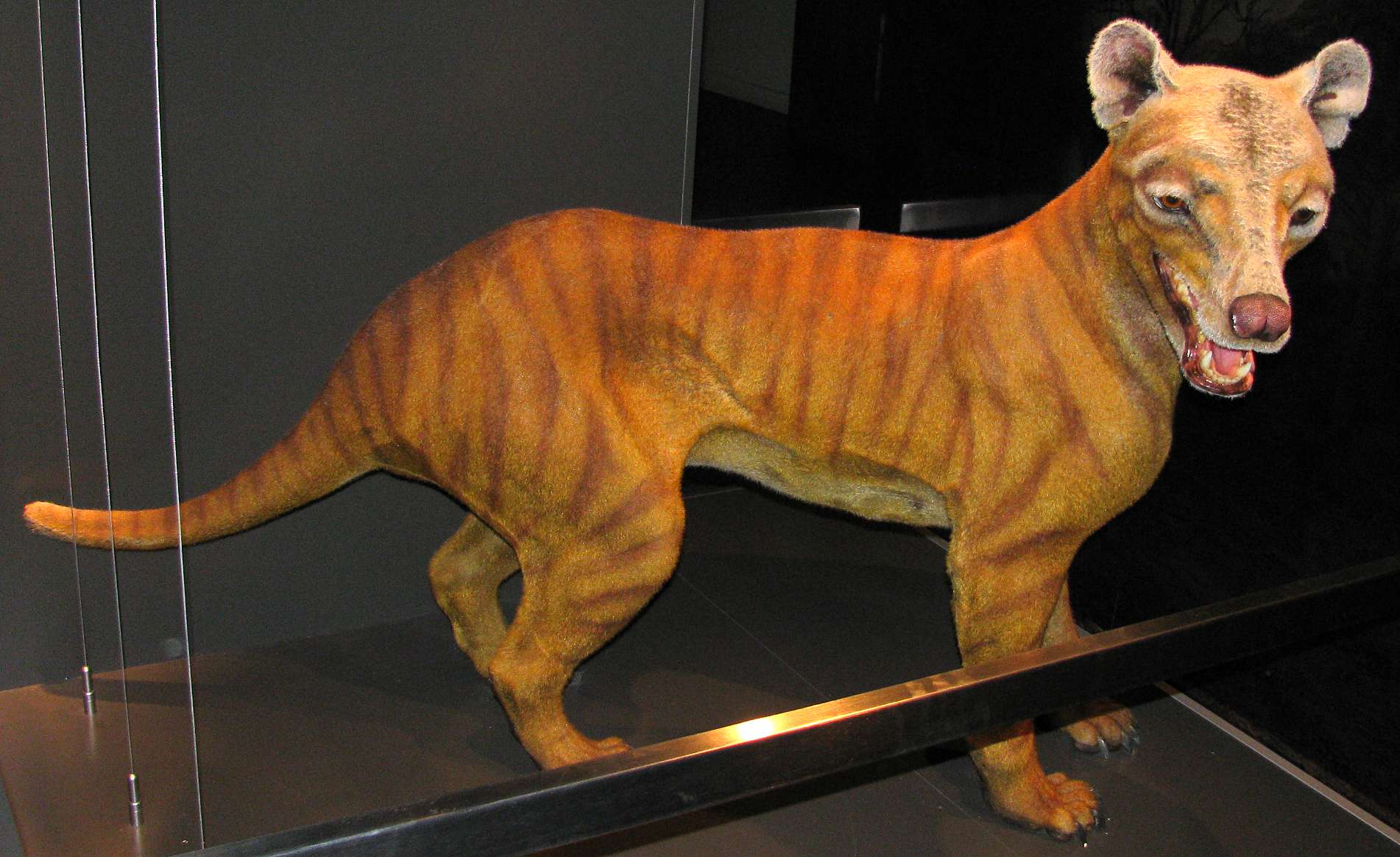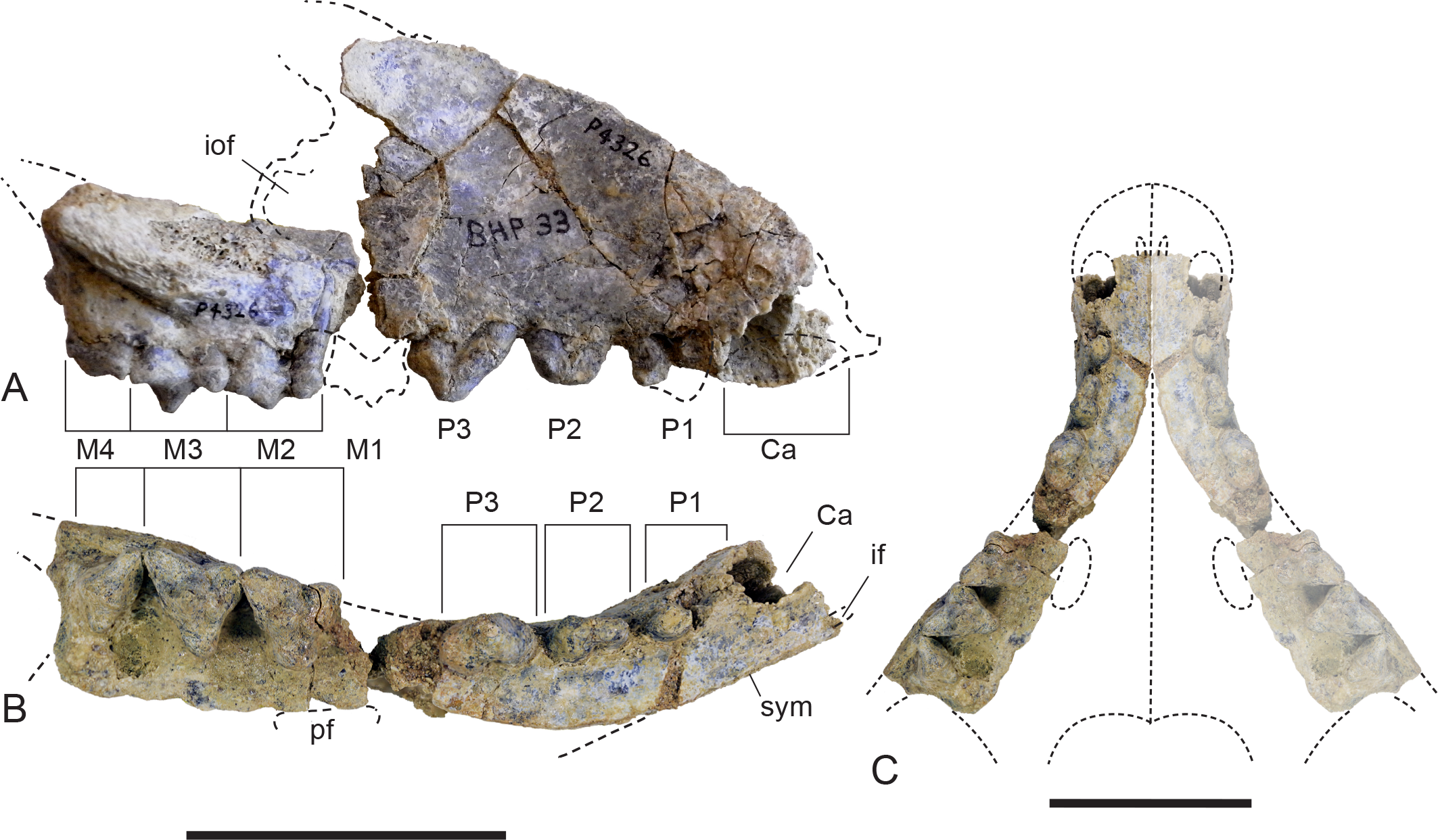Post by Infinity Blade on Apr 22, 2015 4:55:22 GMT 5
Powerful Thylacine-Thylacinus potens

An illustration of T. potens. © @ Michael Ströck
Temporal range: Late Miocene (10-8Ma)
Scientific classification:
Domain: Eukaryota
(unranked): Unikonta
(unranked): Opisthokonta
(unranked): Holozoa
(unranked): Filozoa
Kingdom: Animalia
Phylum: Chordata
Subkingdom: Eumetazoa
(unranked): Bilateria
Superphylum: Deuterostomia
Phylum: Chordata
Infraphylum: Gnathostomata
Clade: Eugnathostomata
Clade: Teleostomi
Superclass: Tetrapoda
Clade: Reptiliomorpha
Clade: Amniota
Clade: Synapsida
Clade: Eupelycosauria
Clade: Sphenacodontia
Clade: Sphenacodontoidea
Order: Therapsida
Suborder: Cynodontia
Clade: Prozostrodontia
Clade: Mammaliaformes
Class: Mammalia
Legion: Cladotheria
Sublegion: Zatheria
Infralegion: Tribosphenida
Subclass: Theria
Clade: Metatheria
Infraclass: Marsupialia
Superorder: Australidelphia
Order: Dasyuromorphia
Family: †Thylacinidae
Genus: †Thylacinus
Species: †T. potens

A model of T. potens.
The powerful thylacine (Thylacinus potens; 'powerful pouch') is a species of thylacine that lived during the Late Miocene. Previously, it had been a rather enigmatic taxon and thought of as a thylacine that was larger and more powerful than the modern thylacine (T. cynocephalus) with a shorter, broader skull.
In 2014 however, more cranial remains attributed to T. potens were described. Based on these new remains, T. potens was more variable in terms of cranial morphology than initially believed. The dentary more more gracile than those of other specimens.
Furthermore, it was found that T. potens held a derived position within its family, close to its more famous relative T. cynocephalus.
T. potens is said to have been larger than T. cynocephalus. Every size estimate (incidentally including a ~120.6 kilogram one that's clearly an overestimate) based on the new remains is in excess of Wroe (2001)'s estimate of ~38.7 kilograms for the holotype specimen. The latter of the two aforementioned thylacine species weighed ~29.5 kilograms on average and ~35 kilograms would have been a maximum weight. Ergo, the notion that T. potens would have been the larger of the two species is in fact correct, unless T. potens possessed unusual body proportions.
Judging from extensive wear from a sample of T. potens dentition (unlike T. cynocephalus), this species of thylacine either practiced durophagy or this was merely exceptional behavior that these particular individuals practiced. However, T. potens lacked adaptations that bone-cracking mammalian carnivores tend to possess (the paper listed the following for example: well-developed cingula and cingulids, broad & low-crowned (essentially brachydont) premolars and lower molars, lower & broader molar cusps, and a placement of the molar cusps towards the tooth's center). Accordingly, if the former notion of T. potens being a habitual bone-cracker is correct, then it must have been a behavior that had only rather recently evolved and adaptations thereof had yet to have evolved.[1]

A reconstruction of T. potens's palate as seen in the 2014 description paper.
References:
[1] "New craniodental remains of Thylacinus potens (Dasyuromorphia: Thylacinidae), a carnivorous marsupial from the late Miocene Alcoota Local Fauna of central Australia" (Yates, 2014).

An illustration of T. potens. © @ Michael Ströck
Temporal range: Late Miocene (10-8Ma)
Scientific classification:
Domain: Eukaryota
(unranked): Unikonta
(unranked): Opisthokonta
(unranked): Holozoa
(unranked): Filozoa
Kingdom: Animalia
Phylum: Chordata
Subkingdom: Eumetazoa
(unranked): Bilateria
Superphylum: Deuterostomia
Phylum: Chordata
Infraphylum: Gnathostomata
Clade: Eugnathostomata
Clade: Teleostomi
Superclass: Tetrapoda
Clade: Reptiliomorpha
Clade: Amniota
Clade: Synapsida
Clade: Eupelycosauria
Clade: Sphenacodontia
Clade: Sphenacodontoidea
Order: Therapsida
Suborder: Cynodontia
Clade: Prozostrodontia
Clade: Mammaliaformes
Class: Mammalia
Legion: Cladotheria
Sublegion: Zatheria
Infralegion: Tribosphenida
Subclass: Theria
Clade: Metatheria
Infraclass: Marsupialia
Superorder: Australidelphia
Order: Dasyuromorphia
Family: †Thylacinidae
Genus: †Thylacinus
Species: †T. potens

A model of T. potens.
The powerful thylacine (Thylacinus potens; 'powerful pouch') is a species of thylacine that lived during the Late Miocene. Previously, it had been a rather enigmatic taxon and thought of as a thylacine that was larger and more powerful than the modern thylacine (T. cynocephalus) with a shorter, broader skull.
In 2014 however, more cranial remains attributed to T. potens were described. Based on these new remains, T. potens was more variable in terms of cranial morphology than initially believed. The dentary more more gracile than those of other specimens.
Furthermore, it was found that T. potens held a derived position within its family, close to its more famous relative T. cynocephalus.
T. potens is said to have been larger than T. cynocephalus. Every size estimate (incidentally including a ~120.6 kilogram one that's clearly an overestimate) based on the new remains is in excess of Wroe (2001)'s estimate of ~38.7 kilograms for the holotype specimen. The latter of the two aforementioned thylacine species weighed ~29.5 kilograms on average and ~35 kilograms would have been a maximum weight. Ergo, the notion that T. potens would have been the larger of the two species is in fact correct, unless T. potens possessed unusual body proportions.
Judging from extensive wear from a sample of T. potens dentition (unlike T. cynocephalus), this species of thylacine either practiced durophagy or this was merely exceptional behavior that these particular individuals practiced. However, T. potens lacked adaptations that bone-cracking mammalian carnivores tend to possess (the paper listed the following for example: well-developed cingula and cingulids, broad & low-crowned (essentially brachydont) premolars and lower molars, lower & broader molar cusps, and a placement of the molar cusps towards the tooth's center). Accordingly, if the former notion of T. potens being a habitual bone-cracker is correct, then it must have been a behavior that had only rather recently evolved and adaptations thereof had yet to have evolved.[1]

A reconstruction of T. potens's palate as seen in the 2014 description paper.
References:
[1] "New craniodental remains of Thylacinus potens (Dasyuromorphia: Thylacinidae), a carnivorous marsupial from the late Miocene Alcoota Local Fauna of central Australia" (Yates, 2014).



